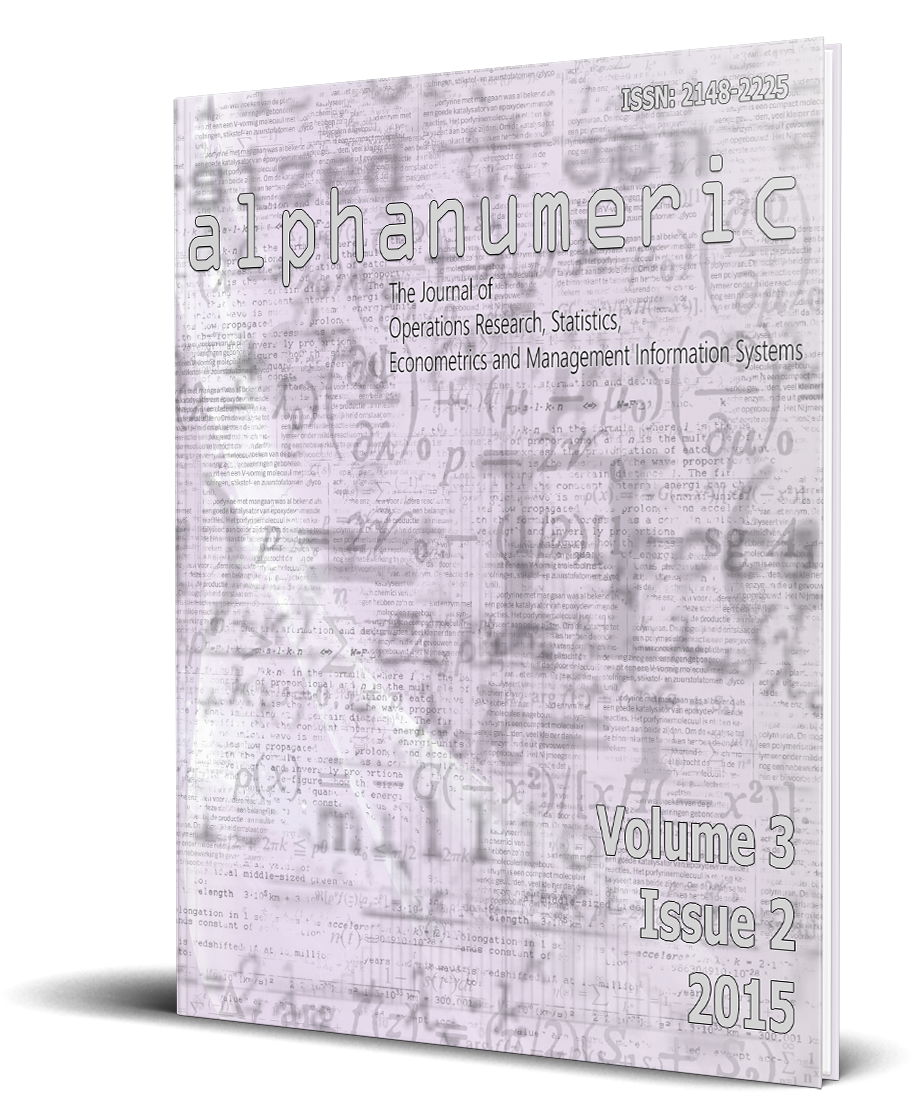
alphanumeric journal
The Journal of Operations Research, Statistics, Econometrics and Management Information Systems
Outliers in Survival Analysis
Abstract
Survival analysis is a collection of statistical methods for analyzing data where the outcome variable is the time until the occurrence of an event of interest. Outliers in survival anaysis calculated differently from classical regression analysis. Outlier detection methods in survival analysis are commonly carried out based on residuals and residual analysis. In survival analysis, there are different types of residuals that are Cox-Snell, Martingale, Schoenfeld, Deviance, Log-odds and Normal deviance residuals. There are methods which are DFBETA, LMAX and Likelihood Displacement values for detecting influential observations. The residuals are analyzed during the study which is applied on a stomach cancer data set and the outliers are detected. After omitting these outliers, model is set up again and results were found better.
Keywords: Influential Observations, Outliers, Residuals, Survival Analysis, Survival Models
Jel Classification: C10, C14, C19, C24
Yaşam Çözümlemesinde Aykırı Değerler
Öz
Yaşam çözümlemesi, tanımlanan herhangi bir olayın ortaya çıkmasına kadar geçen sürenin incelenmesinde kullanılan istatistiksel yöntemler bütünüdür. Yaşam çözümlemesinde aykırı değerler klasik regresyonda kullanılan yöntemlerden farklı yöntemler kullanılarak hesaplanmaktadır. Yaşam çözümlemesinde aykırı değer belirleme yöntemleri artıklara ve artıkların analizine dayanmaktadır. Yaşam çözümlemesinde kullanılan başlıca artık türleri Cox-Snell, Martingale, Schoenfeld, Sapma, Log-odds ve Normal sapma artıklarıdır. Etkili gözlemleri belirlemek için kullanılan yöntemler ise DFBETA, LMAX ve Olabilirlik Değişim değerleridir. İncelenen artık türleri mide kanseri ile ilgili verilere uygulanmış ve aykırı değerler belirlenmiştir. Belirlenen aykırı değerler çıkarılarak model yeniden kurulmuş ve aykırı değerler çıkarıldığında sonuçların daha iyi olduğu görülmüştür.
Anahtar Kelimeler: Artıklar, Aykırı Değerler, Etkili Gözlemler, Yaşam Modelleri, Yaşam Çözümlemesi
Suggested citation
(). Yaşam Çözümlemesinde Aykırı Değerler. Alphanumeric Journal, 3(2), 139-152. http://dx.doi.org/10.17093/aj.2015.3.2.5000149382
References
- Ata, N., Sertkaya, D., Sözer, M.T., (2007). “Orantılı Tehlike Varsayımının İncelenmesinde Kullanılan Yöntemler ve Bir Uygulama”, Eskişehir Osmangazi Üniversitesi Mühendislik Mimarlık Fakültesi Dergisi, XX, S.1.
- Barlow ,W. E., Prentice, R. L., (1988). Residuals for relative risk regression, Biometrika, 75, 65 – 74.
- Collett, D., (1994). Modelling Survival Data in Medical Research, Chapman &Hall/CRC.
- Cox, D. R., Snell, E. J., (1968). “A General Definition of Residuals”, Journal of the Royal Statistical Society, 30, 2, 248-275.
- Cox, D.R., Oakes, D., (1984). Analysis of Survival Data, Chapman and Hall, London.
- Elandt-Johnson, R. C., Johnson, N. L., (1980). Survival Models and Data Analysis, John Wiley& Sons, Inc, New York.
- Eroğlu, A., Altınok, M., Özgen, K., Sertkaya, D., (1997). “A Multivariate Analysis of Clinical and Pathological Variables in Survival After Resection of Gastric Cancer”, Türkiye Klinikleri Medical Research, 15, 1, 15-20.
- Fitrianto, A., Jiin, R. L. T., (2013). “Several Types of Residuals in Cox Regression Model: An Emprical Study”, International Journal of
- Mathematical Analysis, 7,73, 2645-2654.
- Flemming, T. R., Harrington, D. P., (1991). Couting Processes and Survival Analysis, Wiley, New York.
- Gharibvand, L. and Fernandez, G., (2008). Advanced Statistical and Graphical Features of SAS® PHREG, SAS GLOBAL Forum 2008 Conference proceedings San Antonio TX.
- Gharibvand, L., Jeske, D.R., Liao, S., (2008). Evaluation of a Hospice Care Referral Program Using Cox Proportional Hazards Model, Western Users of SAS Software Conference, Universal City, CA.
- Hosmer, D. W., Lemeshow, S., (1999). Applied Survival Analysis: Regression Modeling of Time to Event Data, Wiley&Sons, New York.
- Klein, J. P., Moeschberger, M. L., (2003). Survival Analysis: Techniques for Censored and Truncated Data., Springer, New York.
- Kleinbaum,D.G., Klein,M., (2005). Survival analysis: A Self-Learning Text, Second Edition, Springer.
- Kul, S., (2010) “The Use of Survival Analysis for Clinical Pathways”, International Journal of Care Pathways,14, 23–26.
- Lin, D. Y., Wei, L. J., Ying, Z., (1993). “Checking the Cox Model with Cumulative Sums of Martingale-Based Residuals”, Biometrika, 80, 3, 557-572.
- Nardi, A., Schemper, M., (1999). “New Residuals for Cox Regression and Their Application to Outlier Screening”, Biometrics, 55, 2, 523-529.
- Nardi, A., Schemper, M., (2003). “Comparing Cox and Parametric Models in Clinical Studies”, Statistics in Medicine, 22, 3597-3610.
- Noh, N. A., (2010). Detecting Outliers and Influential Observations in Survival Model, Master Thesis, University of Malaya, Institute of Mathematical Sciences, Kuala Lumpur.
- Schoenfeld, D., (1982). “Partial Residuals for the Proportional Hazards Regression Model”, Biometrika, 69, 239-241.
- Stepanova, M., Thomas, L., (2002). “Survival Analysis Methods for Personal Loan Data”, Operations Research, 50, 2, 277-289.
- Tableman, M., Kim, J.S., (2004). Survival Analysis Using S: Analysis of Time-to-Event Data, Chapman & Hall/CRC.
- Terzi, Y., Cengiz, M.A., Bek, Y., (2005). “Cox Regresyon Modelinde Oransal Hazard Varsayımının Artıklarla İncelenmesi ve Akciğer Kanseri Hastaları Üzerinde Uygulanması”, Türkiye Klinikleri Tıp Bilimleri Dergisi, 25, 770-775.
- Therneau, T. M., Grambcsh, P. M., Fleming, T. R., (1990). “Martingale-based Residuals for Survival Models”, Biometrika, 77, 1, 147-160.
- Therneau, T. M., Grambsch, P. M., (2000). Modeling Survival Data: Extending Cox Model, Springer, New York.
- Winnett, A, Sasieni, P., Miscellanea: (2001). “A Note on Scaled Schoenfeld Residuals for the Proportional Hazards Model”, Biometrika, 88, 565-71.
- Yay, M., Çoker, E., Uysal, Ö., (2007). “Yaşam Analizinde Cox Regresyon Modeli ve Artıkların İncelenmesi”, Cerrahpaşa Tıp Dergisi, 38, 139 – 145.
2015.03.02.STAT.08
alphanumeric journal
Pages 139-152
Received: Nov. 2, 2015
Accepted: Dec. 27, 2015
Published: Dec. 31, 2015
2015 Karasoy, D., Tuncer, N.
This is an Open Access article, licensed under Creative Commons Attribution-NonCommercial 4.0 International License.

scan QR code to access this article from your mobile device
Contact Us
Faculty of Transportation and Logistics, Istanbul University
Beyazit
Campus 34452 Fatih/Istanbul/Türkiye
Bahadır Fatih Yıldırım, Ph.D.
editor@alphanumericjournal.com
+ 90
(212) 440 00 00 - 13219
alphanumeric journal
alphanumeric journal has been publishing as "International Peer-Reviewed Journal" every six months since 2013. alphanumeric serves as a vehicle for researchers and practitioners in the field of quantitative methods, and is enabling a process of sharing in all fields related to the operations research, statistics, econometrics and management informations systems in order to enhance the quality on a globe scale.

